Your Ultimate Captain Cook Snorkel Tour Guide
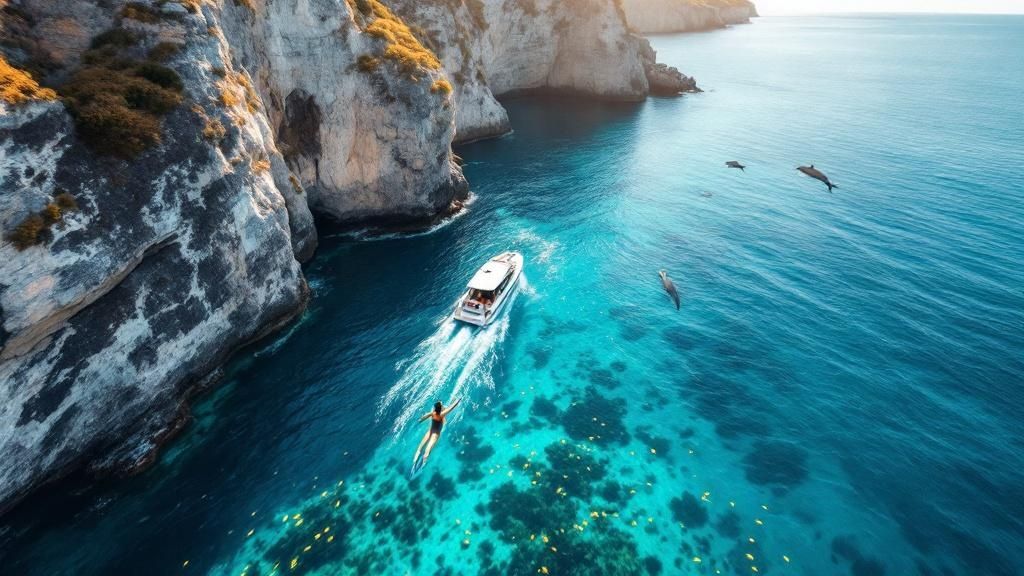
A Captain Cook snorkel tour is your ticket to the crystal-clear waters of Kealakekua Bay, hands down one of the most stunning marine sanctuaries in all of Hawaii. It’s a special kind of adventure, one that weaves together world-class snorkeling over vibrant coral reefs with a fascinating look into the island’s past. This experience truly has something for everyone, whether you're a die-hard ocean lover or a history enthusiast.
Why Choose a Captain Cook Snorkel Tour
Picture this: you're effortlessly gliding through calm, turquoise water, floating above a bustling underwater city bursting with color. That's the core of what it feels like to snorkel in Kealakekua Bay, a protected marine reserve on the Big Island. But this trip is about more than just what you see below the surface—it’s like jumping into a living history book.
A Captain Cook snorkel tour expertly combines the breathtaking underwater scenery with the powerful story of Captain James Cook’s arrival in Hawaii back in 1779. This historic bay is where the British explorer first landed, an event that forever altered the course of the islands' history. The famous white obelisk of the Captain Cook Monument, standing tall against the lush green cliffs, is a constant, striking reminder of this moment.
An Adventure for Everyone
This tour really isn't built for just one type of person. Its unique mix of history and nature makes it a fantastic choice for all sorts of people, guaranteeing a Hawaiian experience you won't soon forget.
- For the Adventure Seeker: The boat ride itself, cruising along the Kona coast, is a thrill. Add in the excitement of discovering a whole new underwater world and the chance to spot pods of playful spinner dolphins, and you've got a real adventure on your hands.
- For the Nature Lover: Kealakekua Bay is a Marine Life Conservation District for a reason. It’s a protected haven for hundreds of species of tropical fish, graceful green sea turtles (honu), and some of the healthiest coral you’ll see anywhere.
- For the History Buff: This tour offers a real, physical connection to the past. The guides are amazing storytellers, often sharing compelling tales about Captain Cook's fateful interactions with Native Hawaiians, which adds a rich, cultural layer to your day on the water.
It's this blend of incredible natural beauty and deep historical significance that truly makes the tour special. You aren't just swimming in a giant aquarium; you're exploring a place that holds profound meaning in Hawaiian culture and world history.
When you sign up for a Captain Cook snorkel tour, you're getting so much more than a simple boat trip. You're choosing an experience that will teach you, inspire you, and show you some of the most spectacular views on the Big Island—both above and below the waves. To see exactly what the trip is like from start to finish, check out this complete guide to the Captain Cook snorkel tour that breaks down every detail. It’s an adventure that promises memories to last a lifetime.
The History Behind Kealakekua Bay
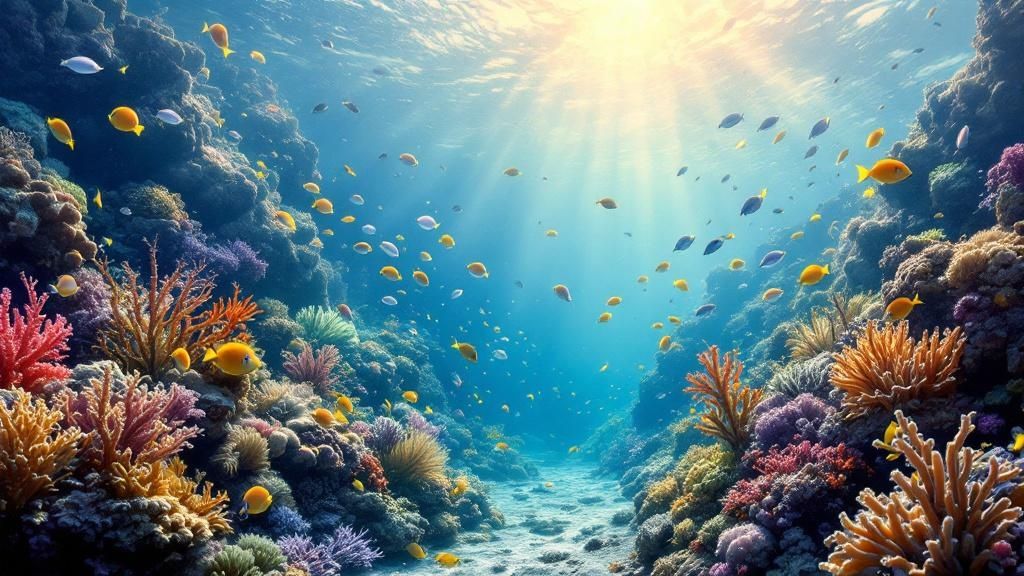
When you join a Captain Cook snorkel tour, you’re doing more than just exploring vibrant coral reefs. You're stepping into a living history book. The story of this place adds a powerful new dimension to your adventure, turning a beautiful day on the water into a journey back in time. The bay's name, Kealakekua, even translates to "the pathway of the god"—a name that turned out to be eerily prophetic.
It all started in 1779. When British explorer Captain James Cook sailed his ships, the HMS Resolution and HMS Discovery, into this protected bay, the timing of his arrival was unbelievable. It happened to be during the Makahiki festival, a sacred annual season of peace and celebration honoring the Hawaiian god Lono.
Imagine being there. You're part of a peaceful, ancient festival when two massive, otherworldly ships with towering masts appear on the horizon. For the Native Hawaiians, this was a mind-blowing event. Many believed that Captain Cook was Lono himself, returning from the sea as ancient prophecies foretold.
A Complex Welcome
At first, things went well. The Hawaiians greeted Cook and his crew with incredible ceremonies and generosity, treating them like deities. Cook, a skilled navigator and cartographer, spent his time mapping the coastline and documenting the culture he encountered.
But the goodwill was fragile. Cultural misunderstandings started to pile up, and the strain of hosting hundreds of foreign sailors for weeks began to show. Tensions grew when Cook’s men, unaware of Hawaiian customs, started taking resources and breaking sacred rules, slowly eroding the belief that they were divine.
This real-life drama unfolded right where you’ll be snorkeling, making the Captain Cook snorkel tour a truly unique experience.
The powerful story of Kealakekua Bay is what sets it apart. You aren't just swimming in any beautiful spot; you're exploring a place that marks a pivotal moment in Hawaiian history, where two completely different worlds collided with permanent consequences.
The Fateful Encounter
The breaking point came after Cook had already left. A storm damaged a mast on one of his ships, forcing an unexpected return to Kealakekua Bay for repairs. But by this time, the Makahiki festival was over, and the Hawaiians' view of Cook had completely changed. He was no longer seen as the god Lono.
The situation spiraled out of control quickly, leading to a confrontation on the shoreline over a stolen boat. In the clash that followed on February 14, 1779, Captain James Cook was killed. This tragic event cemented the bay’s place in global history, and the stark white monument you see from the tour boat marks this very spot.
This rich history is a huge draw for the more than 190,000 visitors who come here annually. While its status as a Marine Life Conservation District protects its incredible reefs, about 70% of visitors are deeply interested in the area's history, while the other 30% are primarily focused on the snorkeling.
The Monument and Its Legacy
That iconic white obelisk on the shore isn't just a landmark. It's technically a small piece of Great Britain. The plot of land it stands on was deeded to the United Kingdom, and the monument is still maintained by the British Royal Navy, marking the approximate location where Cook died.
Your tour guides are usually fantastic storytellers, and they'll share these captivating details on the way to the bay. Hearing the history while looking at the very cliffs and shore where it all happened adds a layer of meaning that you just can’t get from a book. It helps you understand why Kealakekua Bay is so carefully protected as a historical and cultural site. For a deeper look at the monument and its story, you can learn more about where the Captain Cook Monument is located.
Finding the Right Captain Cook Snorkel Tour For You
Picking a Captain Cook snorkel tour can feel overwhelming at first. A quick search shows you dozens of options, and they all seem to promise the same thing: a trip to the magnificent Kealakekua Bay. But here’s the secret—the boat you choose and the company you go with will completely shape your day. It’s the difference between a good time and an absolutely unforgettable one.
Not all tours are created equal. The key is to find the one that fits your idea of a perfect day on the water. Are you looking for a high-speed adventure, or a relaxed cruise with your family? Knowing what you want is the first step to booking the right trip.
What Kind of Snorkeler Are You?
Before you even start comparing tour companies, take a second to think about what you really want out of the experience. This little bit of self-reflection is the most important part of the process. It ensures you don't end up on a party boat when you wanted a quiet day, or vice-versa.
-
The Serious Snorkeler: You're here for one reason: to see the reef. Your main goal is getting as much time in the water as possible with guides who can point out cool marine life. You couldn't care less about waterslides or fancy drinks.
-
The Family Vacationer: Safety and comfort come first. You need a boat that’s stable, has easy access into the water, and maybe a few extras to keep the kids happy. Lunch and flotation gear are non-negotiable.
-
The Adventure Seeker: The journey is just as important as the destination. You want the thrill of a fast boat, the chance to zip into sea caves, and a bit of spray in your face. A little excitement is part of the fun for you.
-
The Relaxation Cruiser: Your goal is a peaceful, beautiful day on the ocean. A leisurely sail, stunning coastal views, and a chill vibe are far more important than how many fish you can count.
Once you know which group you fall into, picking the right kind of tour becomes so much easier.
Big Boats vs. Small Rafts
The biggest difference between most Captain Cook snorkel tour operators boils down to one thing: the boat they use. This single choice affects everything—from how many people you're with to the amenities on board and the overall atmosphere of the trip.
Think of the large, double-decker catamarans as the cruise ships of Kealakekua Bay. They offer an incredibly smooth and stable ride, which is perfect if you have young kids or if anyone in your group is prone to seasickness. These boats often come loaded with features like:
- Onboard restrooms
- Plenty of shaded seating
- Fun extras like waterslides or high-dive platforms
- A full lunch buffet and sometimes even a bar
On the other end of the spectrum, you have the small, nimble Zodiac-style rafts. These are built for pure fun and adventure. The ride is fast, bumpy, and exhilarating as you race along the Kona coast, ducking into sea caves and lava tubes that the bigger boats can't get anywhere near. These tours almost always mean smaller groups, which translates to a more personal and intimate experience.
Once you get in the water, you're in for a treat. Here's a snapshot of what to expect.
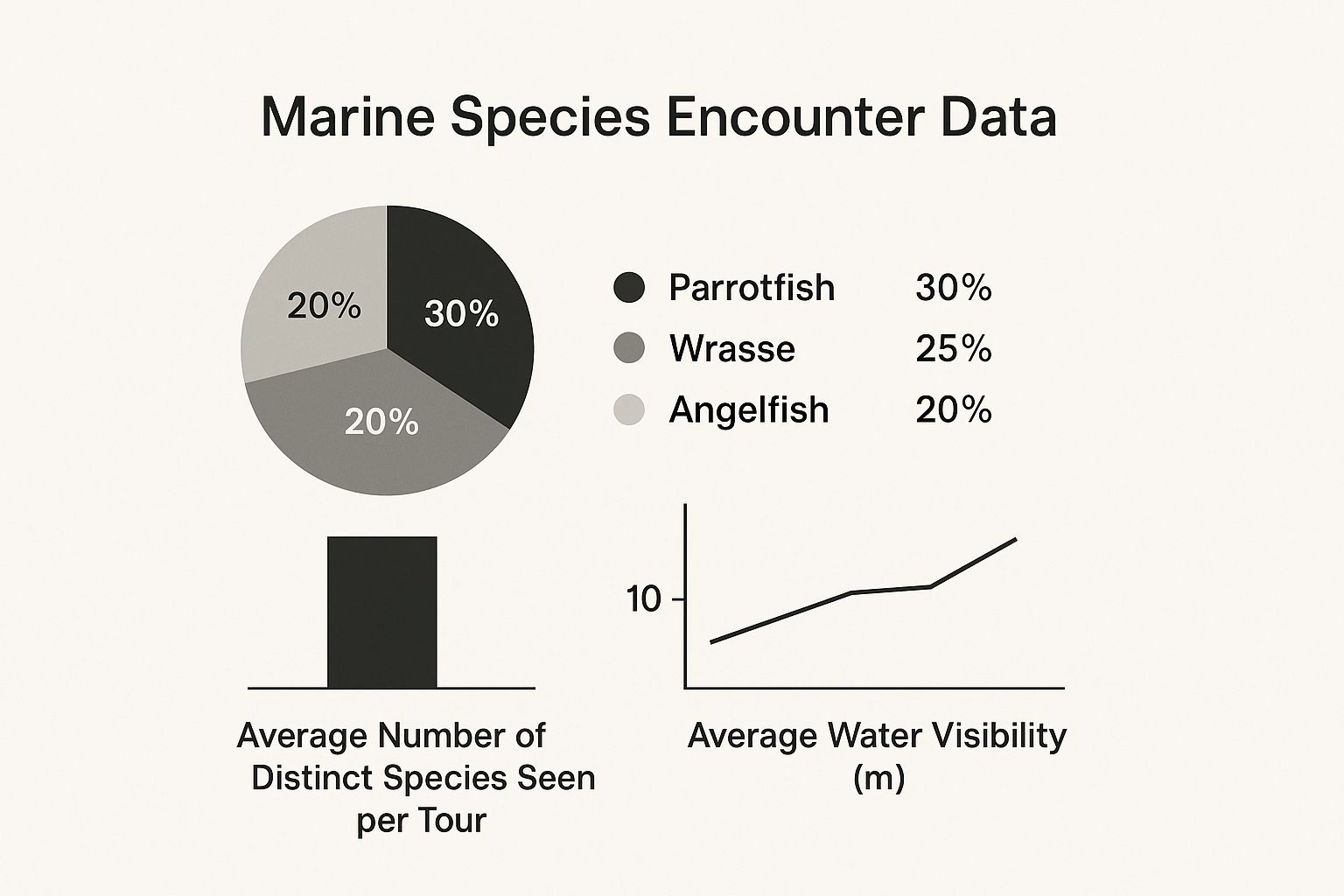
The conditions at Kealakekua Bay are consistently incredible. It's common to spot 15 or more different types of fish during a single swim, with water clarity often reaching an amazing 20 meters (about 65 feet).
A Look at Different Tour Operators
To help you visualize the options, let’s look at how different companies cater to different snorkelers. It’s all about finding the right match for your group's size, desired trip length, and overall vibe.
Comparison of Captain Cook Snorkel Tour Operators
This table breaks down the main styles of tours you'll find heading to Kealakekua Bay. Use it to quickly see which one aligns with your vacation plans.
| Tour Style | Typical Group Size | Average Duration | Best For | Price Range |
|---|---|---|---|---|
| Large Catamaran | 20 – 40+ guests | 5 hours | Families with kids, non-swimmers, those wanting amenities (lunch, slides) | $$ – $$$ |
| Small Group Raft | 12 – 20 guests | 3 – 4 hours | Adventurous couples, families with older kids, sea cave exploration | $$ – $$$ |
| Intimate Sailboat | 6 – 12 guests | 4 hours | Relaxation seekers, serious snorkelers, personalized attention | $$$ – $$$$ |
| Historical Tour | 6 – 10 guests | 4 hours | History buffs, those wanting a narrative-driven experience | $$ – $$$ |
As you can see, there’s no single "best" option—it's about what’s best for you.
The tour you pick really can make or break your day. To dive deeper into specific companies and what they offer, check out our guide on the different Kona snorkel tours options. It will help you weigh the pros and cons of each style, ensuring you book a Captain Cook snorkel tour you’ll be raving about for years.
What Marine Life Will You See in Kealakekua Bay?
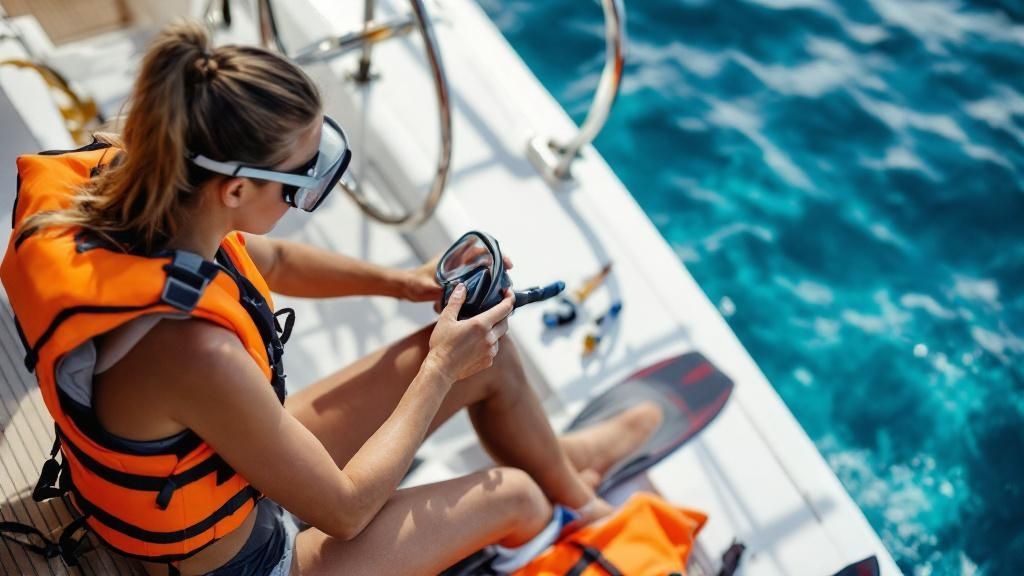
Dipping your face below the surface of Kealakekua Bay isn’t just getting wet—it’s like stepping through a portal into another world. The water here is alive, a bustling underwater city teeming with color and motion.
The secret to this incredible vibrancy is the bay's status as a Marine Life Conservation District. This isn't just some official-sounding name; it's a protective shield that has allowed the local ecosystem to flourish for decades. The result is one of the healthiest, most densely populated coral reefs in all of Hawaii, with visibility often reaching an incredible 65 feet. This protected status is what makes a Captain Cook snorkel tour a truly special encounter with marine life, where the underwater drama is just as compelling as the history on the shore.
Your Underwater Field Guide
Forget trying to remember generic "tropical fish." Snorkeling here is about meeting a real cast of characters, each with its own personality. It’s like swimming through a living rainbow, and knowing who you're looking at makes the whole experience come alive.
Almost as soon as you get in the water, you’ll be greeted by schools of Yellow Tang. You can't miss these brilliant, canary-yellow fish as they move in synchronized groups, a flash of sunshine against the deep blue. They’re the bay’s cheerful welcoming committee.
Keep an eye out for the different kinds of Butterflyfish. Their intricate patterns and graceful movements are captivating as they flutter around the coral heads, often traveling in pairs. They're a favorite for underwater photographers and casual snorkelers alike.
And of course, no trip to Hawaii is complete without spotting our state fish: the Humuhumunukunukuāpuaʻa. Good luck with the name! This feisty little triggerfish is a true island icon, easily recognized by its bold markings and unique shape.
Kealakekua Bay acts like a safe harbor, allowing fish populations to thrive without the pressures of fishing. This means you'll see more fish, larger fish, and a greater variety of species than almost anywhere else on the Kona coast.
The Stars of the Show: Naiʻa and Honu
While the reef fish are amazing, two larger residents have a knack for capturing everyone's hearts. A sighting is often the highlight of the trip—a moment of pure Hawaiian magic.
First are the playful spinner dolphins, or naiʻa in Hawaiian. These acrobatic mammals are famous for their incredible leaps and spins. Pods of them often come into the calm bay to rest during the day after a long night of hunting in the deep ocean. It’s not uncommon for tour boats to be greeted by these dolphins, who seem to enjoy escorting vessels into the bay.
Then there are the wise, ancient Green Sea Turtles, known as honu. Watching one of these gentle giants glide effortlessly over the reef is a truly serene and unforgettable experience. As they navigate the coral gardens or surface for a breath of air, you can’t help but feel a connection. Just remember, these are protected animals, so always give them plenty of space and never, ever touch them.
Why Is the Bay So Healthy?
The thriving ecosystem you see today is no accident; it’s the direct result of decades of careful protection. As a Marine Life Conservation District, the bay has strict rules that allow it to flourish.
- No Fishing: A complete ban on fishing lets fish populations grow to their natural sizes and numbers.
- Healthy Coral: The calm, sheltered waters are the perfect nursery for coral growth, which forms the foundation of the entire ecosystem.
- Crystal-Clear Water: Limited coastal development and runoff mean the water stays exceptionally clear—perfect for snorkeling.
This powerful combination of factors is what makes every Captain Cook snorkel tour a front-row seat to one of nature's most spectacular underwater shows. It’s a chance to immerse yourself in a world that’s just waiting to be discovered.
How to Prepare for Your Day on the Water
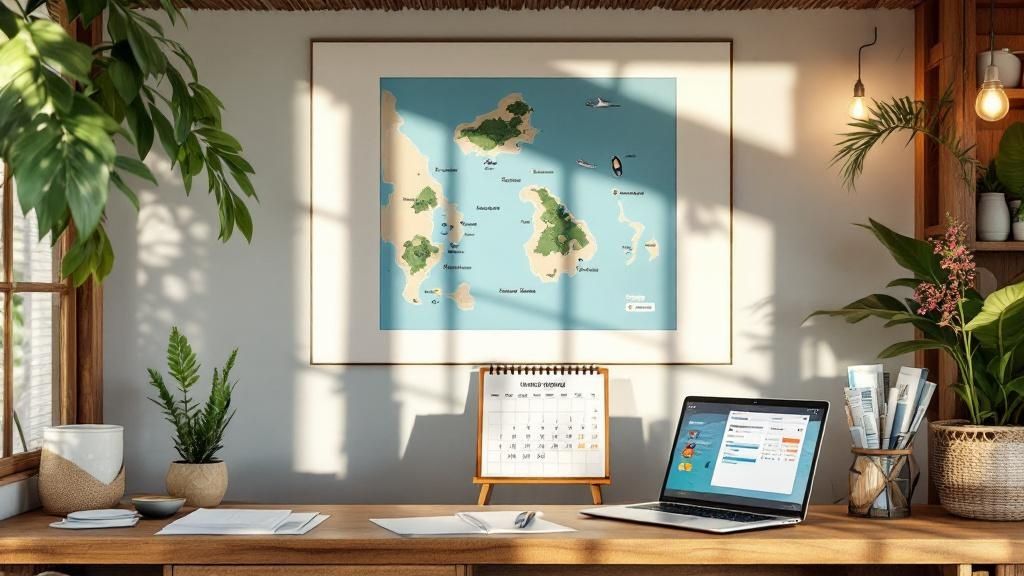
A little bit of prep work goes a long way in making your Captain Cook snorkel tour truly unforgettable. By packing smart, you can get all the logistics out of the way beforehand. That way, once you step onto the boat, your only job is to soak in the incredible views and get ready for the adventure.
Think of this as your pre-trip checklist. We’ll go over what you absolutely need to bring, what the tour company will likely have for you, and a few insider tips to make your day as smooth and comfortable as possible. Get this sorted now, and you can spend your tour time enjoying the magic of Kealakekua Bay.
What to Pack in Your Day Bag
The good news is, you don’t need to pack much. The goal is to bring just what you need for a day out in the sun and sea without being weighed down by a heavy bag.
Here are the absolute essentials:
- Towel & Change of Clothes: Nothing beats drying off with a fresh towel and having a dry set of clothes for the comfortable ride back to shore.
- Sun Protection: The Hawaiian sun is no joke, especially when it’s reflecting off the water. A wide-brimmed hat, polarized sunglasses, and a rash guard or cover-up will be your best defense.
- Waterproof Camera: Whether you have a GoPro or just a waterproof case for your phone, you won’t want to miss capturing the world beneath the waves.
- Reusable Water Bottle: Staying hydrated is crucial. Most tours provide water for refills, and bringing your own bottle is a great way to cut down on plastic waste.
The single most important thing to pack is reef-safe sunscreen. Your standard sunscreen probably contains chemicals like oxybenzone and octinoxate, which cause serious damage to coral reefs. Look for a mineral-based sunscreen with zinc oxide or titanium dioxide—it’s a simple switch that helps protect the very ecosystem you’ve come to admire.
What Your Tour Company Provides
One of the best parts about joining a professional Captain Cook snorkel tour is that they take care of all the gear. This lets you pack light and not worry about hauling equipment around.
Most reputable tour operators, like those at Kona Snorkel Trips, will provide:
- Snorkel Gear: This includes a high-quality, sanitized mask, snorkel, and fins fitted just for you.
- Flotation Devices: Not a confident swimmer? No problem. They’ll have flotation noodles, belts, or vests to help you relax and float effortlessly.
- Food and Drinks: Always check your specific tour details, but the majority include snacks, a full lunch, and plenty of drinks to keep you energized.
Tips for a Smooth Experience
Beyond what’s in your bag, a few extra pointers can really elevate your day. If you’re prone to motion sickness, it’s a good idea to take an over-the-counter remedy before you get on the boat. The Kona coast is stunning, but the water can get a little choppy.
If this is your first time snorkeling, pay close attention to the crew’s safety briefing. They’re lifeguard-certified pros who can show you all the tricks, like how to clear water from your mask, so you can feel completely at ease in the water.
What’s really interesting is that a modern Captain Cook snorkel tour offers so much more than just a swim. A big reason these trips are so popular—with around 70% of visitors choosing them for this very reason—is how they blend the incredible marine life with Hawaii’s rich history. Guides often share fascinating stories and cultural insights, turning a fun day on the water into a truly meaningful journey. You can find out more about this unique approach over at konasnorkeltrips.com.
Frequently Asked Questions About the Tour
Taking a Captain Cook snorkel tour is a highlight for any Big Island trip, but it's completely normal to have a few questions before locking things in. Getting the details sorted out is the key to a stress-free day, so we've put together some straightforward answers to the questions we hear most often.
Think of this as your final check-in before you book. We’ll cover everything from who the tour is right for to the best time of year to go and, most importantly, how to be a great guest in this very special place. Let's get you all the info you need so you can book with confidence and just look forward to the adventure.
Is This Tour Good for Kids and Non-Swimmers?
Absolutely! This is one of the most common worries we hear, and the answer is a definite yes. Tour crews are pros at creating a safe, fun, and comfortable environment for absolutely everyone, no matter their age or how they feel about being in the water.
For kids, the calm, protected waters of Kealakekua Bay are basically a giant natural swimming pool. Seeing those bright, tropical fish up close for the first time is pure magic and can easily spark a lifelong love for the ocean.
If you're not a strong swimmer, don't let that hold you back. The tour operators have you covered with top-notch safety and flotation gear.
- Flotation Vests and Belts: These let you float effortlessly on the surface. You can just relax and watch the underwater show without having to worry about treading water.
- Pool Noodles: Sometimes the simplest tools are the best. They offer extra buoyancy and are great for just hanging out comfortably in the water.
- Lifeguard-Certified Crew: Your guides are professionally trained to keep an eye on everyone. They are fantastic at giving tips and a little extra help to make first-timers feel completely at ease.
Your crew's number one job is to make sure you feel safe and have an incredible time. They have years of experience helping children and nervous adults discover the underwater world securely and with a smile.
When Is the Best Time of Year to Go?
Here’s the great news: a Captain Cook snorkel tour is a fantastic experience any time of year. The weather on the Big Island is beautifully consistent, and Kealakekua Bay’s geography shelters it from big ocean swells, which keeps the water calm and clear almost all the time.
That said, there are a couple of small seasonal differences you might want to consider:
- Summer (May – September): This is typically the driest and calmest season. You can pretty much count on warm, sunny days and exceptionally smooth water, making it perfect for families with younger kids.
- Winter (December – March): While there might be a slightly higher chance of a passing shower, the real draw of winter is whale season. You have a very good chance of spotting majestic humpback whales from the boat as they breach and play along the coast.
Ultimately, the "best" time really just depends on what you're hoping for. If glassy water is your top priority, summer is your best bet. If the thought of seeing whales adds to the magic, book a winter trip.
Should I Book My Tour in Advance?
Yes, without a doubt. We strongly recommend booking your tour in advance, especially if you’re visiting during peak travel times like holidays, spring break, or the summer months. The best tours—particularly the ones that pride themselves on smaller, more intimate group sizes—fill up fast.
Booking ahead gives you a few major advantages:
- Guarantees Your Spot: You won’t have to deal with the disappointment of your preferred tour being sold out, a common headache for last-minute planners.
- More Options: You'll get your pick of the best tour operators, different types of boats, and the departure times that work best for your schedule.
- Stress-Free Planning: Getting your tour locked in early is one less thing to organize once you're in Hawaii. You can just relax and anticipate the fun ahead.
It's a lot like making a dinner reservation at that one restaurant everyone wants to go to. You wouldn't just show up on a Saturday night expecting to get a table, and the same thinking applies here.
How Can I Be a Respectful Visitor in the Bay?
This might just be the most important question of all. Kealakekua Bay isn't just a world-class snorkel spot; it's a designated Marine Life Conservation District and a wahi pana—a sacred and storied place in Hawaiian culture. Visiting with respect is crucial to protecting its natural beauty and honoring its deep cultural history.
Practicing good snorkel etiquette is simple, but it makes a world of difference. The golden rule is to never, ever touch anything. That means the coral, the fish, and especially the sea turtles (honu). The oils on our skin can harm delicate coral ecosystems, while touching marine animals can cause them stress and is illegal in Hawaii.
Here are a few more tips for being a truly mindful snorkeler:
- Use Reef-Safe Sunscreen: As mentioned before, standard chemical sunscreens are toxic to coral. Always choose a mineral-based sunscreen.
- Keep Your Distance: Admire all marine life from afar. Give turtles, dolphins, and other creatures plenty of room to go about their business.
- Don't Stand on the Coral: Always be aware of where your fins are. Accidentally kicking or standing on the reef can cause damage that takes decades, if not centuries, to recover.
- Listen to Your Guides: They are your connection to this place. They're experts on the local ecosystem and cultural protocols, so listen to their briefings and the stories they share about the bay's significance.
By following these simple guidelines, you’re not just a tourist—you become a partner in conservation, helping ensure that the magic of the Captain Cook snorkel tour can be experienced for generations to come.
Ready to experience the magic of Kealakekua Bay for yourself? Kona Snorkel Trips offers Hawaii's highest-rated and most-reviewed snorkel adventures, led by lifeguard-certified guides who prioritize your safety and fun. Book your unforgettable Captain Cook snorkel tour today!
